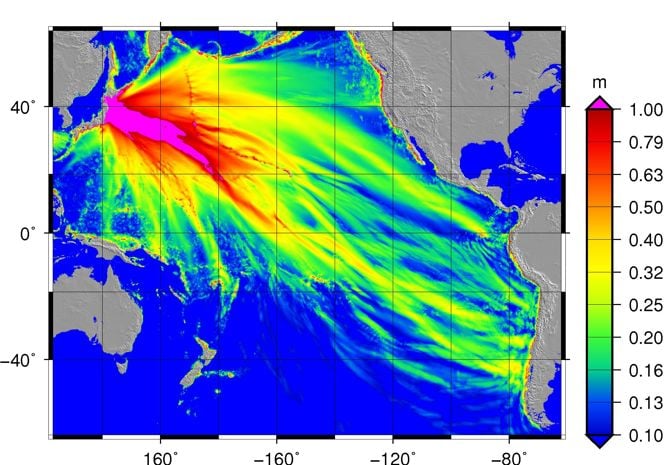Japan Tsunami 11 March 2011
At 0546Z on March 11, an earthquake located east of Tokyo, Japan generated a huge tsunami. The location of the earthquake was about 100 km from land. Analysis shows that the main direction of the tsunami waves was south-east towards Hawai, as experienced. And the analysis compares well with the measured wave heights in the buoys in the Pacific.

Predicted wave height in the Pacific Ocean after the Japan earthquake Friday 11 March 2011
More detailed information on the initial surface elevation due to the earthquake is now available, including sea bed deformations and the direction of the faults. Such vital information, in addition to topography and water depth in the affected area, has enabled tsunami experts at NGI to do a more elaborate analysis of the tsunami propagation over the entire Pacific Ocean due to the Japan earthquake.
The oceans of the world are constantly monitored to reveal and detect possible new tsunamis. So-called DART buoys are used for this purpose. By comparing measured wave height in the buoys in the Pacific in the relevant time span to the predicted wave heights, one can see the quality of the analysis. The figures in the picture gallery (upper right on the screen) show good correspondence between measured and predicted results. This can be seen in all four DART-buoys located in the region towards Japan (four first pictures). The location of the buoys is shown in the two first figures in row two in the picture gallery (click picture for enlargement).
For the evaluation of future tsunamis, it is vital to have trust in the analysis methods and predictions of how the tsunami propagates. In this way, the analysis may be used for warning in affected areas where the tsunami will come. A good match between predictions and measurements will also provide a good understanding of the incident and process of tsunami generation and propagation and is vital in the continued work on risk evaluation and warning.
After the main earthquake, the analysis shows that the coast of Japan was hit by 7-10 m waves within about one-half hour of the earthquake. The analysis also shows that the main direction of the tsunami into the Pacific was dominant towards south-east. And also that the waves were smaller in the southwest and northern directions, towards Papa New Guinea, The Philippines, and Russia. Also, the wave heights reduced as they propagated over the Pacific Ocean.
